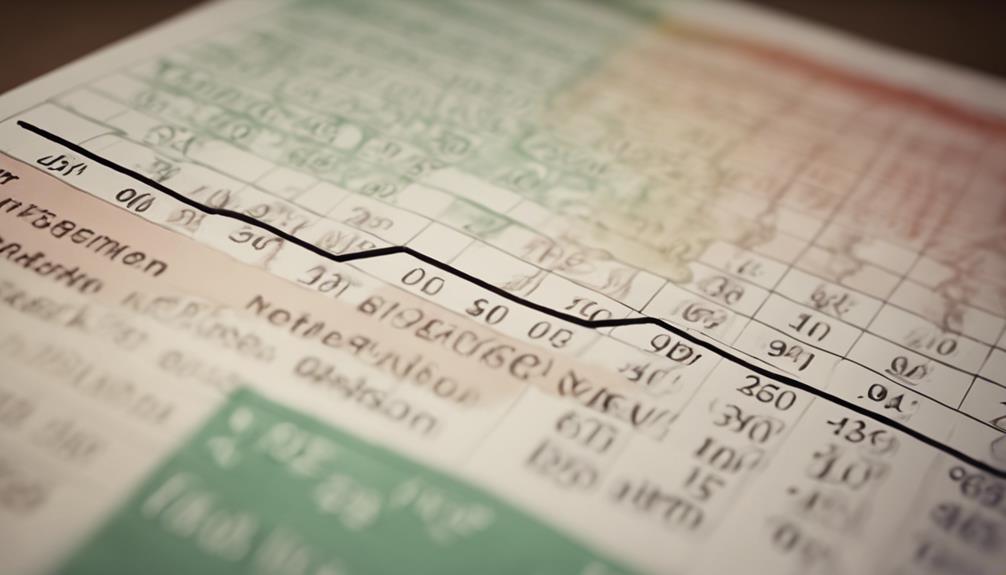Determining the appropriate rate of return for retirement depends on factors such as risk tolerance, current market conditions, and past performance. Creating realistic expectations involves taking into account fees, taxes, and the impact of inflation. Achieving a balance between risk and returns through asset diversification and making strategic decisions is crucial. Analyzing past performance helps in accurately projecting growth. Strategies that maximize returns include diversifying portfolios and having a good understanding of inflation rates. Adjusting asset allocation helps combat the effects of inflation. Diversification improves portfolio stability during retirement. To gain more insight on securing a financially stable future, it is essential to explore various factors like diversification, asset allocation, and historical performance.
Key Takeaways
- Consider historical stock market returns averaging around 7%.
- Evaluate impact of fees, taxes, and inflation on returns.
- Aim for a realistic rate aligned with historical performance.
- Seek advice from financial advisors for optimal portfolio success.
- Balance risk and returns through diversified asset allocation.
Factors Affecting Rate of Return
When considering retirement planning, understanding the factors affecting the rate of return is essential for making informed investment decisions. Factors such as risk tolerance, historical performance of asset classes, and market conditions all play a significant role in determining the realistic rate of return for your portfolio.
As we age, our risk tolerance changes, impacting the types of assets we should invest in to achieve our financial goals. Different investment types offer varying rates of return, features, and fees to take into account, making it vital to align our choices with our long-term objectives.
Additionally, the historical performance of various asset classes provides valuable insights into how they may behave in the future, aiding in strategic decision-making. Market conditions, influenced by economic trends and global events, can also sway the rate of return on investments.
Consulting a financial advisor can help navigate these complexities and optimize portfolio success for a secure retirement.
Setting Realistic Expectations

Setting Realistic Expectations for retirement planning involves accurately evaluating the impact of fees, taxes, and inflation on investment returns to guarantee a clear understanding of the actual income generated. When considering the Rate of return for retirement, it's important to factor in these elements to determine a realistic rate of return.
Historical stock market returns, which typically average around 7% after adjusting for inflation, fees, and taxes, play a significant role in shaping retirement projections. Understanding the implications of income taxes on investments is critical for calculating the real rate of return.
Merely relying on the nominal rate of return can be misleading, as it doesn't account for fees, taxes, and inflation, making accurate retirement planning challenging. To ensure precise retirement projections, one must use a realistic rate of return that aligns with historical market performance while adjusting for various deductions.
This approach is key to setting achievable goals and securing your financial future.
Balancing Risk and Returns
When considering retirement planning, it's important to strike a balance between risk and returns. We aim to optimize our investment choices to meet our financial goals effectively.
This involves understanding our risk tolerance and diversifying our assets to manage risk while maximizing returns.
Risk Vs. Returns
Balancing risk and returns in retirement planning involves carefully weighing the potential for investment gains against the likelihood of losses. Understanding our risk tolerance is key to determining the right level of risk to take on in our portfolio.
While higher risk investments offer the potential for greater returns, they also bring increased volatility and the risk of loss. Diversifying across different asset classes can help reduce overall portfolio risk while still aiming for best returns.
It's essential to regularly rebalance our portfolio to maintain the desired risk-return profile and adapt to changing market conditions. By considering these factors, we can strike a balance that aligns with our retirement goals and risk appetite.
Finding the Balance
In determining the ideal balance between risk and returns for retirement planning, it's essential to assess our risk tolerance, investment objectives, and time horizon. Understanding the relationship between risk and return is vital for making informed investment decisions.
Diversifying your portfolio across various asset classes can help manage risk and optimize returns. Higher risk investments offer the potential for higher returns but also come with increased volatility. Evaluating the trade-offs between risk and potential returns is key to developing a suitable retirement investment strategy.
Seeking advice from a financial advisor can aid in asset allocation and portfolio management. By considering our investment goals and time horizon, we can find the balance that aligns with our risk tolerance, ultimately enhancing our retirement planning.
Historical Performance Analysis

When analyzing historical performance, we consider past returns across different asset classes. The impact of inflation on investment growth is also a crucial factor in our analysis. We also delve into how to assess risk in our portfolios.
Past Returns Comparison
Analyzing historical performance data provides valuable insights into the past returns of the S&P 500 over various 30-year periods, helping in projecting potential growth for retirement portfolios.
Historical CAGR for the S&P 500, after inflation adjustments, has ranged from 5.07% to 8.24%. Comparing different 30-year periods, we see variations in CAGR, like 5.07% for 1960-1989, 8.24% for 1970-1999, and 7.52% for 1980-2009.
It's essential to use CAGR over simple averages for accurate market return assessment. Past performance data shows S&P 500 CAGR between 10.30% and 13.78% before inflation adjustments.
Understanding these historical returns is key to projecting potential growth for retirement portfolios and making informed decisions in retirement planning.
Impact of Inflation
Considering historical U.S. inflation rates ranging from 1.5% to 4% annually, it becomes apparent that understanding the impact of inflation on investment returns is vital for accurate retirement planning. Inflation can erode the purchasing power of investments over time, emphasizing the need to aim for inflation-adjusted returns.
Mismatched returns with inflation can diminish the real rate of return, impacting the value of financial projections for retirement. By factoring in inflation rates, individuals can make more precise retirement plans that safeguard against the loss of purchasing power.
It's essential to take inflation into account when calculating the rate of return on investments to ensure that financial goals align with the reality of rising prices and changing economic conditions.
Risk Assessment
To assess the risk levels and potential returns for retirement planning, we explore analyzing historical performance data. By evaluating how different asset classes have fared over time, we can make informed decisions about risk.
It's essential to take into account the volatility and fluctuations in historical returns of various investment options. Using past performance analysis helps us understand the level of risk associated with different investment strategies. Historical data provides valuable insights into how investment choices may impact retirement savings.
Strategies for Maximizing Returns

To maximize returns in retirement planning, diversifying your investment portfolio is an essential strategy that can help reduce risk exposure and enhance potential returns. Investing in stocks can serve as a hedge against inflation, potentially boosting overall returns.
Additionally, purchasing inflation-linked bonds like Treasury Inflation-Protected Securities (TIPS) can help offset inflation risks, safeguarding your financial goals. Prioritizing short-term bonds in your investment portfolio allows for quicker responses to market changes, optimizing your returns.
Another effective strategy is relocating to more affordable areas, which can combat inflation and make your retirement funds go further. By diversifying your portfolio and considering these strategies, you can't only hedge against inflation but also position yourself to achieve your financial objectives in retirement.
Inflation's Impact on Returns

As we explore the impact of inflation on returns, it becomes evident that understanding and adapting to inflation rates is vital for maintaining the purchasing power of investments. Inflation, which historically ranges from 1.5% to 4% per year in the U.S., plays a significant role in accurate investment return calculations. Mismatched returns in comparison to inflation can erode the purchasing power of investments over time. It's noteworthy that personal inflation rates may differ from the national average, making it essential to take individual circumstances into account when planning for retirement.
To combat the impact of inflation on investment returns, adjusting asset allocation is key. By strategically diversifying investments across different asset classes, investors can better position themselves to withstand the effects of inflation. This proactive approach can help guarantee that the real value of investments is preserved, even in the face of changing economic conditions. By staying informed and making informed decisions, individuals can navigate the complexities of inflation and safeguard their financial future.
Importance of Diversification

Diversification across various asset classes is essential for minimizing risk and optimizing returns in investment portfolios. By spreading investments across different types of assets, such as stocks, bonds, and real estate, investors can reduce the impact of market downturns on their overall portfolio. Studies have shown that a diversified portfolio can increase risk-adjusted returns over time, aligning with the principles of Modern Portfolio Theory. This approach emphasizes the benefits of diversification in balancing risk and return, particularly important in retirement planning. Asset allocation models guide investors in strategically distributing their investments to achieve diversification effectively.
In the domain of retirement planning, the significance of diversification can't be exaggerated. It serves as a key strategy to mitigate risks and enhance the long-term performance of a portfolio. By incorporating a diverse range of assets, individuals can better navigate the uncertainties of the market and position themselves for financial stability during their retirement years.
Frequently Asked Questions
What Is a Good Rate of Return for Retirement Planning?
For retirement planning, a good rate of return typically falls between 5% to 12% annually. It's important to take into account inflation when evaluating returns to make sure they maintain their real value.
The investment period must align with the expected rate of return for successful planning. Understanding inflation and time horizons is key to determining the right rate of return.
These factors play a significant role in shaping our retirement savings strategy.
What Is a Good Interest Rate to Use for Retirement Planning?
For effective retirement planning, selecting the appropriate interest rate is essential. We must consider real returns after fees, taxes, and inflation adjustments.
An example could be aiming for a rate that takes into account historical stock market performance but also considers the impact of taxes and fees. This balanced approach helps guarantee our retirement savings grow steadily while taking into account potential financial obstacles.
Is a 7% Return Realistic?
A 7% return is realistic for retirement planning. It accounts for inflation, fees, and taxes, making it a solid choice. Historical stock market averages suggest around 10% before adjustments, but 7% is a safer bet overall.
Understanding how fees and taxes impact your earnings is key. Balancing risk and return is essential when aiming for a 7% realistic return in retirement planning.
What's a Good Rate of Return for a 401k?
A important rate of return for a 401k can vary depending on factors such as asset allocation and market conditions. Historically, 401k investments have averaged between 5% to 8% annually.
It's essential to monitor and adjust your investments to optimize returns for retirement planning. Diversification and regular contributions can also enhance long-term growth.
What Factors Should I Consider When Determining the Right Rate of Return for Retirement Planning?
When choosing retirement rate of return, consider factors such as your age, risk tolerance, and long-term financial goals. A higher rate could mean higher risk, while a lower rate may not keep up with inflation. Consult with a financial advisor to determine the best strategy for your retirement planning.
Conclusion
As we sail through the unpredictable waters of retirement planning, it's essential to steer wisely and aim for the right rate of return.
By understanding the factors that influence returns, setting realistic expectations, and diversifying our investments, we can navigate towards a secure financial future.
Remember, the winds of inflation may blow, but with a well-balanced portfolio and strategic approach, we can weather any storm and set sail towards a prosperous retirement.











